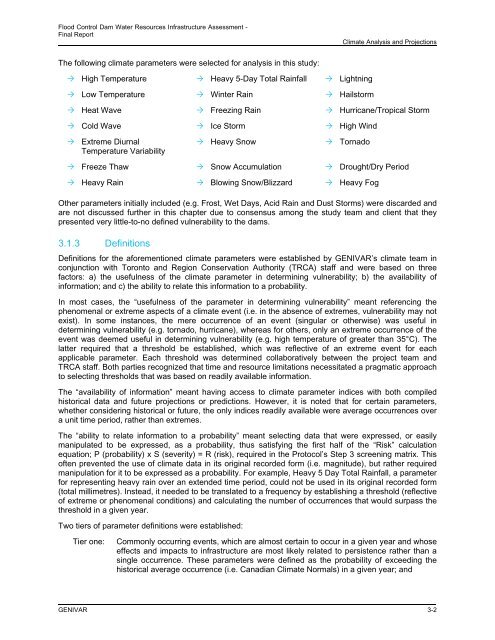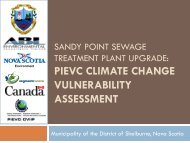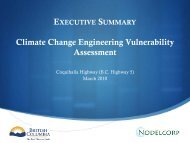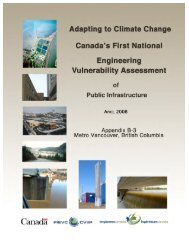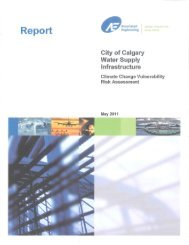Final Report - Vulnerability Committee
Final Report - Vulnerability Committee
Final Report - Vulnerability Committee
Create successful ePaper yourself
Turn your PDF publications into a flip-book with our unique Google optimized e-Paper software.
Flood Control Dam Water Resources Infrastructure Assessment -<strong>Final</strong> <strong>Report</strong>Climate Analysis and ProjectionsThe following climate parameters were selected for analysis in this study: High Temperature Heavy 5-Day Total Rainfall Lightning Low Temperature Winter Rain Hailstorm Heat Wave Freezing Rain Hurricane/Tropical Storm Cold Wave Ice Storm High Wind Extreme DiurnalTemperature Variability Heavy Snow Tornado Freeze Thaw Snow Accumulation Drought/Dry Period Heavy Rain Blowing Snow/Blizzard Heavy FogOther parameters initially included (e.g. Frost, Wet Days, Acid Rain and Dust Storms) were discarded andare not discussed further in this chapter due to consensus among the study team and client that theypresented very little-to-no defined vulnerability to the dams.3.1.3 DefinitionsDefinitions for the aforementioned climate parameters were established by GENIVAR’s climate team inconjunction with Toronto and Region Conservation Authority (TRCA) staff and were based on threefactors: a) the usefulness of the climate parameter in determining vulnerability; b) the availability ofinformation; and c) the ability to relate this information to a probability.In most cases, the “usefulness of the parameter in determining vulnerability” meant referencing thephenomenal or extreme aspects of a climate event (i.e. in the absence of extremes, vulnerability may notexist). In some instances, the mere occurrence of an event (singular or otherwise) was useful indetermining vulnerability (e.g. tornado, hurricane), whereas for others, only an extreme occurrence of theevent was deemed useful in determining vulnerability (e.g. high temperature of greater than 35°C). Thelatter required that a threshold be established, which was reflective of an extreme event for eachapplicable parameter. Each threshold was determined collaboratively between the project team andTRCA staff. Both parties recognized that time and resource limitations necessitated a pragmatic approachto selecting thresholds that was based on readily available information.The “availability of information” meant having access to climate parameter indices with both compiledhistorical data and future projections or predictions. However, it is noted that for certain parameters,whether considering historical or future, the only indices readily available were average occurrences overa unit time period, rather than extremes.The “ability to relate information to a probability” meant selecting data that were expressed, or easilymanipulated to be expressed, as a probability, thus satisfying the first half of the “Risk” calculationequation; P (probability) x S (severity) = R (risk), required in the Protocol’s Step 3 screening matrix. Thisoften prevented the use of climate data in its original recorded form (i.e. magnitude), but rather requiredmanipulation for it to be expressed as a probability. For example, Heavy 5 Day Total Rainfall, a parameterfor representing heavy rain over an extended time period, could not be used in its original recorded form(total millimetres). Instead, it needed to be translated to a frequency by establishing a threshold (reflectiveof extreme or phenomenal conditions) and calculating the number of occurrences that would surpass thethreshold in a given year.Two tiers of parameter definitions were established:Tier one:Commonly occurring events, which are almost certain to occur in a given year and whoseeffects and impacts to infrastructure are most likely related to persistence rather than asingle occurrence. These parameters were defined as the probability of exceeding thehistorical average occurrence (i.e. Canadian Climate Normals) in a given year; andGENIVAR 3-2


